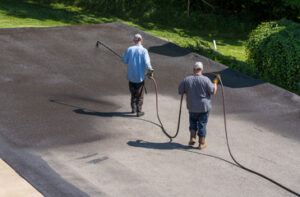Rochester NY Sealcoating is a process that protects asphalt pavement from water, oil, UV damage, and other elements. It also adds a rich, dark color to the surface, enhancing curb appeal.

The seal coating process is best performed from spring through fall because it requires dry weather. During the process, all vehicles must be removed from the area, and the parking lot will be blocked off with cones and barricades.
Asphalt is a mix of rock, stone and gravel held together with a binder, which is made from the distillation process of certain crude oils. When this material deteriorates, it causes the pavement to degrade and turn brittle over time. Sealcoating slows this process and protects the asphalt surface from weather damage. It also helps to prevent cracks and potholes from forming in the asphalt surface.
Sealcoating is typically done in spring or fall, when the climate conditions are optimum for the job. It needs to be warm and dry for the sealant to bond well with the asphalt. It shouldn’t rain within 24 hours of applying the seal coat. It’s also a good idea to have all vehicles off of the driveway or parking lot before workers start the project.
Once the surface is clear of all visible materials, workers will power wash the surface before applying the sealant. This will remove oil and other stains that can interfere with the proper bonding of the new sealcoat. It’s important to use high-quality power washing equipment for this step to ensure the best results.
The workers working on the sealcoating project should have all of the necessary PPE, or personal protective equipment, to keep themselves safe. This includes a face mask, safety glasses and gloves. These products will help to protect the workers’ skin and lungs from chemicals in the sealant. One exposure may not cause any harm, but repeated contact could result in long-term health issues.
Lastly, workers should make sure to fill all cracks and holes in the asphalt surface before starting the sealcoating process. This will prevent water from seeping into the cracks and further damaging the pavement. It’s also important to clean the area to be sealed before starting, so the sealant bonds properly with the asphalt surface.
It’s a good idea to sealcoat a newly-paved asphalt surface at least once every three years. This will extend the life of the asphalt and give it a better appearance for a lower cost than full repair or resurfacing. It’s also a much safer alternative to driving on a badly damaged or worn surface.
It Prevents Stains
Over time, sunlight, standing water and harsh weather can cause asphalt to fade. While this isn’t damaging to the pavement, it can look unattractive and make your business or property look neglected. Sealcoating can prevent this fading and give the pavement an attractive new appearance.
Oil and gas stains are difficult to remove once they set, but sealcoating can prevent them from occurring in the first place. This will help you avoid the expensive repair and cleanup costs associated with these stains.
In addition to preventing stains, sealcoating can also prevent the cracks and other damage caused by these stains. If left untreated, these damages will continue to worsen and may require large scale repairs that can cost several thousand dollars per square foot. Sealcoating is a much more affordable option and can protect your investment by extending the lifespan of your asphalt.
There are many different types of sealcoats on the market, but the most common ingredient is refined coal tar. This is a thick liquid that is the byproduct of the distillation of bituminous coal. Some manufacturers use additives to adjust the performance of the sealcoat and improve its functionality. For example, some additives help the sealcoat dry faster and at a more uniform rate, while others can increase flexibility or resistance to salts and chemicals.
It’s important to note that sealcoating is not a permanent solution and it will need to be reapplied every few years. It’s also a good idea to have your pavement inspected after it has been sealed to ensure that the sealant is still doing its job.
The main benefit of having your pavement professionally sealcoated is that it will protect the surface from harmful elements. It will also save you money in the long run, as it will prolong the life of your driveway or parking lot. Additionally, it will prevent costly repairs and make your property more appealing.
Before a sealcoat is applied, it’s important to prepare the area. This includes cleaning it of any debris and oil, and making any necessary repairs. It’s also important to close off the area to pedestrians and vehicles for 24 hours. You should also make sure that your sprinklers are turned off.
It Makes the Surface More Durable
Asphalt is made from a mixture of rock and sand aggregate and petroleum based binder. Over time as the pavement ages the petroleum product breaks down, leaving voids in the rock. Water, dirt and other substances can get in these voids and cause the pavement to crack. Seal coats replace the lost binder, making the surface more durable and extending its lifespan.
Sealcoating is usually applied in two coats and must dry fully between applications. It is very important that the application process is done properly to achieve maximum durability and longevity. The first step is to ensure the asphalt surface is completely clean and free of oil stains, dirt, debris and any other contaminants that may damage the new sealcoat. The surface must also be fully swept and pressure washed before the sealcoat is applied. The sealcoat can be applied with either spray or squeegee equipment and should be continuously agitated during the application process to ensure consistency of the mix.
During the application of the sealcoat it is very important to not splash the product or allow it to drip on other surfaces such as concrete walkways, garage doors and car siding. This will cause permanent staining and is extremely difficult to remove. A professional sealcoat company will use specialized equipment to prevent these problems.
Once the sealcoat is applied, it must be allowed to cure for 24 to 48 hours before vehicles can be driven on the surface. It is recommended that you create a maintenance plan with a professional sealcoat company like Maintain It All to ensure your investment in the asphalt is protected for years to come.
Sealcoating is a cost-effective solution to protecting your asphalt and improving its lifespan. However, it is not a replacement for complete parking lot repairs or patching. It will only add a few years to an already deteriorated parking lot and should be used as part of a comprehensive maintenance program for your asphalt. A well-maintained sealcoated surface is safe for pedestrians, cyclists and vehicle drivers and will enhance the look of your property.
It Promotes Safety
A seal coat helps improve traction on a pavement surface, which is important for anyone who uses that area. This is particularly true on a parking lot, where cars drive over the surface frequently. If the pavement is slippery, it can pose a danger for pedestrians and drivers, and it can be a liability risk for business owners who want to protect their customers and employees. A seal coat with added sand helps to promote safety and ensure that people can walk and drive on the surface without slipping or falling.
It can also help prevent vehicles from sliding on the asphalt, which can cause damage. This can be caused by oil spills and other chemical substances that soften the material. The sand added to the sealant helps to create an extra barrier that keeps these chemicals from seeping into the asphalt and damaging it. This can save businesses money in the long run because it prevents the need to repair or replace damaged asphalt.
Another benefit of seal coating is that it can give faded pavement a fresh black appearance. Over time, the sun’s UV rays can cause the asphalt to become washed out and grey. However, the seal coat restores the original color and shine to the pavement, which can make it look newer and more attractive and enhance its curb appeal.
A final way that sealcoating can improve safety is by preventing water damage to the pavement. If the pavement is not protected, water can seep into the cracks and freeze in cold weather conditions. This can worsen the cracks and damage the underlying structure. But if the surface is sealed, the water will be repelled, and it will take much longer for the pavement to thaw out after a snowstorm.
